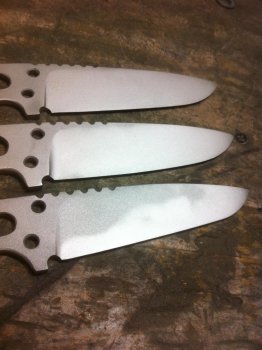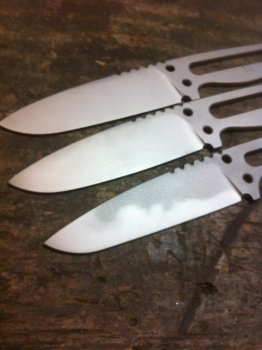Self Made Knives
Well-Known Member
Hey guys, new day, new problem. I recently got some 1095 for NJSB to try instead of the O1 I've been using. My process is to drill, mill, and rough grind the bevels down to about a dime's thickness. I pretty much finish everything but the bevels before heat treat. I use anti-scale compound from Brownells, ATS34 maybe, can't remember the name exactly. I go into oil quench edge first.
After HT I do my finish grind on the bevels, then hand sand to correct and flatten anything I missed on the grinder. I only go up to about 220 grit finish and then abrasive blast for an even matte look. Then I patina the blade. I've used ferric chloride, hot vinegar, Parkerizing, and recently Birchwood Casey Super Blue. The bluing has became my favorite just due to how fast and easy it is.
So, problem, in the pics below you can see the blade on the bottom has a noticeable hamon or temper line. Two on top are O1 and what I'm used to getting. This line affects the final finish a lot! I don't want a temper line! Is there something I can do to make this come out like the O1?


After HT I do my finish grind on the bevels, then hand sand to correct and flatten anything I missed on the grinder. I only go up to about 220 grit finish and then abrasive blast for an even matte look. Then I patina the blade. I've used ferric chloride, hot vinegar, Parkerizing, and recently Birchwood Casey Super Blue. The bluing has became my favorite just due to how fast and easy it is.
So, problem, in the pics below you can see the blade on the bottom has a noticeable hamon or temper line. Two on top are O1 and what I'm used to getting. This line affects the final finish a lot! I don't want a temper line! Is there something I can do to make this come out like the O1?


